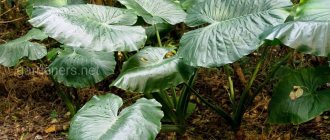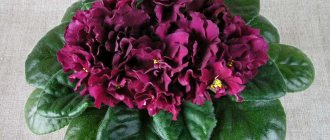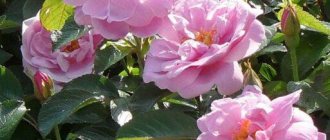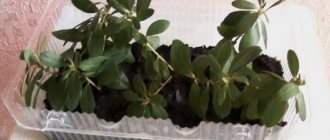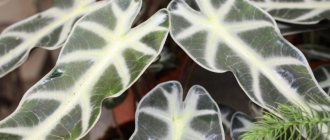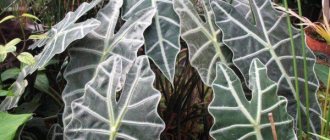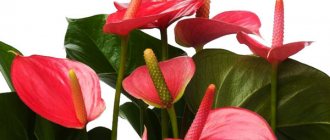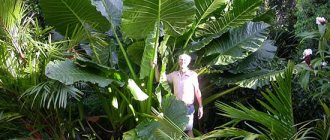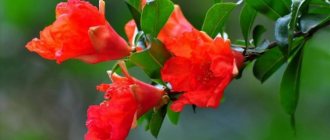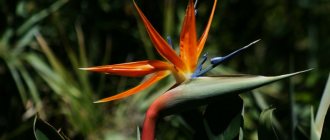The Alocasia plant is a large shrub up to 4 meters in height and 1.5 meters in width. The flower's homeland is the tropical forests of South Africa and areas of the Pacific District. This crop is distinguished by beautiful foliage and powerful thick shoots.
Alocasia leaves have a waxy surface that repels excess moisture. In addition, they secrete residual liquid that was not absorbed by the flower during feeding.
Alocasia Red Secret
A variety of copper alocasia, Alocasia cuprea Red Secret, grown as a houseplant, appeared in the collections of gardeners not long ago, but thanks to its unusual appearance and texture of oval leaves, it has become one of the most popular varieties.
The size of adult specimens, not exceeding 50 cm, makes it easy to keep the flower in any apartment, and the quilted, violet-silver foliage, as if stamped on a sheet of copper, is sure to attract attention and decorate the interior.
The leaf blades are dense and leathery. The lower part has a brighter purple hue than the upper. The cuttings are erect, but as the leaves grow they bend into the ground. The leaves of Alocasia Red Secret reach 30 cm in length, and even upon closer examination it is difficult to believe that the plant is alive and not skillfully made from a sheet of copper.
Home care
Temperature
In spring, summer and autumn, alocasia should be kept in a warm room at a temperature of 21-26 degrees; in winter it is better to place it in cooler conditions, but not lower than 18 degrees.
Lighting
It is important to exclude direct sunlight, but diffused light should be sufficient. Therefore, in winter it is recommended to use additional lighting.
Watering
The plant should be watered and sprayed at least three times a week, but do not allow excessive soil moisture. In winter, the frequency of watering and spraying can be reduced to once a week.
Top dressing
If alocasia does not require restoration, treatment or increased nutrition, then it can be fed with any fertilizer for deciduous plants from March to September, once every two weeks.
Important! It is recommended to dilute fertilizer for copper-red alocasia by reducing the concentration of standard fertilizing by 3 times.
Nitrogen fertilizing can be used to stimulate growth if alocasia does not have enough sun, heat or nutrients for active growth.
Trimming
Typically, pruning and forced renewal (cutting off all leaves) of alocasia are not required. Only dried or rotten leaves are removed. After removal, the wound is lubricated with charcoal.
Transfer
Transplantation should be carried out in the spring. When replanting, you should use a pot 2-3 centimeters larger than the previous one, remove unhealthy leaves and roots, and use suitable soil. It is important to remember that the root collar must be flush with the soil . There is no need to water immediately after transplanting; it is better to do this after the soil in the pot dries.
Care during budding
Alocasia blooms for a short time, about two weeks. During the flowering period, the plant should not be disturbed: do not replant, do not feed, do not move to another room, do not change the temperature.
What to do if it doesn't bloom?
Alocasia blooms if all care conditions are met. Insufficient humidity, temperature, and unsuitable soil can cause the lack of flowers. If the maintenance conditions are met, you can place the plant under stressful conditions: increase the soil temperature using a special display, temporarily reduce watering.
Alocasia Bambino
Alocasia Bambino is a miniature and very original plant that behaves perfectly on window sills and flower racks in apartments. The height of the bush reaches 40 cm, which makes the variety of alocasia shown in the photo an ideal crop for limited space. Despite its miniature size, the plant is sure to attract attention thanks to its arrow-shaped dark green foliage with a purple tint. The back side of the leaf blades is deep purple, the veins are bright, white or yellowish-green.
“ Alocasia Cucul Bambino ” on a flower pot, the gardener should not think that he is seeing a new variety. In this way, some nurseries designate ordinary plants of the Bambino variety, along with it they grow creeping plants of a similar species.
Diseases and pests of indoor plants
The most common problem is a change in the color of the leaves; they can lighten, turn yellow and even fall off. The reason for this may be unsuitable soil, roots damaged during replanting, or insufficient watering. Also, alocasia leaves can get burned if they are exposed to too much direct light. Alocasia can completely shed its leaves if it takes too much effort to bloom.
If the indoor air is too dry, pests may appear - aphids, scale insects, mealyworms and spider mites.
Treatment/control methods
Alocasia is believed to be very resistant to plant diseases.
- If pests are detected, you should use a soap solution or actellik to wipe the stems and leaves.
- Problems caused by inadequate soil quality or indoor climate are solved symptomatically: humidity increases, soil is replaced.
Prevention of various problems
To prevent diseases, you should strictly follow the recommendations for caring for the plant, do not allow the soil to become too moist, and ensure sufficient temperature depending on the season. often recommended not to let alocasia bloom and cut off the flower stalks. This will help prevent the leaves from falling off after flowering has finished.
Alocasia copper-red is a wonderful ornamental plant. She has her own unique image and character, she is poisonous, but beautiful, she is demanding to care for, but with the right approach she pleases the gardener for about 15 years.
Alocasia Bambino Arrow
Like the Bambino variety, its sister, Alocasia Bambino Arrow is a plant mini-form of Alocasia Amazonica. The varieties have a lot in common. The special charm of this variety of alocasia, shown in the photo, is given by the silvery sheen on the glossy dense leaves, which bear a complete resemblance to an ancient arrowhead.
The back of the leaves is purple, with white or silver veining marks. Alocasia Bambino Arrow feels best in partial shade, despite its apparent resistance to dryness; plants, like all other representatives of the species, are very demanding on the amount of moisture received and atmospheric humidity.
Landing
Choosing a pot
The pot for the long roots of alocasia should be tall and rather narrow; the material of the pot can be either plastic or ceramic.
What should the soil be like?
Light, breathable soil helps remove excess moisture and prevents root rot. You can choose any soil that is produced for aroid plants.
You can prepare your own substrate from vermiculite, sand, sphagnum in equal proportions and a small amount of polystyrene foam.
How to transplant?
- First, remove the plant from the pot it is in and remove the roots from the drainage holes.
- Then rinse the roots and, if necessary, remove damaged ones by treating the cut areas with charcoal. Daughter tubers can be left or used for propagation.
- After washing the roots, you need to let the roots dry.
- In order for the plant to take root better, the roots can be soaked in a growth stimulator for 20 minutes before planting.
- Next, you should place drainage, some soil, a plant and the rest of the soil in the pot.
Alocasia Purple Sword
Alocasia lauterbachiana Purple Sword really resembles a bunch of bladed weapons waiting to be used in combat. The leaves are shaped like jagged oriental swords and gave the indoor alocasia pictured in the photo such an unusual name.
The graceful, elongated leaves are dark green in color and are held on the stem by purple or violet cuttings, sometimes with a fancy variegated pattern. The resemblance to swords is given to the plant by the vertical position of the foliage, which does not sink to the ground even when the above-ground part has grown. This variety of alocasia, according to the description and photo, is best kept separately from others. In this case, the plant looks most advantageous. The maximum height of the bush reaches 120 cm.
How does the copper-red islander reproduce?
Alocasia can be propagated by seeds, cuttings or rhizome division .
- To germinate seeds, you need to place the seeds in moist soil, cover with a plastic bag, provide diffused light and warm air temperature (about +27). If these conditions are met, the seeds will germinate in a few days.
- The vegetative propagation method can be used during spring transplantation. You can separate part of the rhizome with a knife or use daughter tubers that form on the surface of the pot. With this method, for successful germination, the temperature should be slightly lower than when propagating by seeds (about +23).
- Propagation by cuttings is also used. A small cutting is soaked in a growth stimulant and planted in a sand-peat mixture, covered with a transparent dome made from a bag or bottle.
Alocasia Elaine
In apartment conditions, Alocasia wentii Aline does well at temperatures of 18–22 °C. This rather large plant attracts attention with its size and stunning variegated leaves. According to the description and photo, alocasia of this species can grow up to one and a half meters in height, which at home requires the allocation of a fairly large area.
In order for Alocasia Elaine to look most advantageous and be as decorative as possible, the plant is placed in a bright place, still protected from direct sunlight. Like other varieties of alocasia, this variety needs sufficient watering. The plant will remove excess moisture through special stomata on the leaf blades, which is very reminiscent of the “crying” of an indoor crop.
Watering a flower
For active growth of the shrub, it is necessary to provide high humidity. Frequent watering should be carried out in the summer. In winter, it is reduced to 1 time every 2 weeks.
To do this, use soft and purified water. It is pre-cleaned using a filter. Hard tap water can cause slow growth and frequent diseases of the root system.
Alocasia macrorrhiza New Guinea Gold
Alocasia large-rooted, Indian or macrorrhiza in nature can reach three meters in height. And although the New Guinea Gold variety is somewhat more compact and does not exceed 1.8 meters in height, the plant enjoys increased attention from both botanists and flower growers.
The fact is that the variety of alocasia shown in the photo was found in Papua New Guinea and still poses a mystery to the scientific world. Scientists cannot explain why and how golden spots appear and disappear on the leaves of the plant. Peltish coloring is present on the stems, veins and petioles of Alocasia of this rare variety. But even with large green leaves, Indian alocasia, as in the photo, is always attractive and will become a bright decoration of any spacious room.
Reviews about growing
Advantages: very beautiful ornamental plant.
Disadvantages: poisonous. I’ve been wanting to buy Alocasia for a long time, but then my husband brought me a shoot from work. Of course, I was pleased and planted it in a beautiful pot. It hasn't grown at all for a very long time, only now, in the spring, it started. What attracts me most about it is the unusual shape and decorative dark green color of the leaves, with bright white veins. This is what I have, and there are also ones with red or purple veins. Of course, since the plant is very poisonous, it should be kept away from children. Alocasia should be watered quite often as the soil dries out, and fertilized during the period of active growth. I fertilize once a month with complex fertilizer. helen-vay
https://otzovik.com/review_933443.html
Pros: handsome!
Disadvantages: capricious, does not take root well in our conditions. Oh, this Alocasia Polly. I bought it in winter. I replanted it in new soil for alocasia, added vermiculite, and finely chopped sphagnum. Added drainage to the bottom. Just a couple of days later, yellow spots appeared on the leaves, then the leaves themselves began to turn yellow. I dug it up and discovered that the bulb and roots had begun to rot. No matter how I tried to revive the bulb, nothing worked. Later I read that alocasia is very prone to rotting bulbs, you need to be careful with watering. Tim82
https://irecommend.ru/content/alokaziya-polli
Alocasia was given to me for my birthday at work.
There were 2 leaves))) Now the beauty has grown, she even wants to bloom! I don’t make any special efforts to grow it, I just don’t put it in the sun and try not to overwater it. Tatiyanna77
https://irecommend.ru/users/tatiyanna77
Alocasia odora Variegata
Even more rare is Alocasia odora Variegata, one of the largest Alocasia grown at home. And this variety also stands out for its variegated decorative foliage in the shape of a huge elephant’s ear.
Interestingly, white or light green areas on leaf blades can look like a scattering of small streaks or create large discolored spots. The length of an adult leaf of the alocasia variety shown in the photo is about 60 cm, the height of an adult plant can reach 2 meters.
How much does it cost in the store? Where can I buy it?
Alocasia is a fairly common indoor flower. In almost all home/DIY stores that have flower sections, you can buy mature specimens of this copper-red beauty. The price of a pot with a flower about 40 centimeters high can range from 600 to 1000 rubles .
You can also often find advertisements for the sale of an adult plant on private classifieds websites. There the price can be about 500 rubles or lower . However, the risks of diseases and problems with the plant will be higher than when buying in a store.
Another source for purchasing copper-red alocasia is ordering from an online store. It is possible to use the services of both Russian and foreign suppliers. Prices may vary depending on the size of the flower, operating conditions of the nursery, and delivery costs.
Alocasia zebrina reticulata
The photo of Alocasia zebrina perfectly conveys all the unusualness of this plant. Thin dark green stains, reminiscent of a pattern on marble or on the skin of an African animal, are clearly visible on the light background color of the leaf plates. The shape of the leaves covered with a thin waxy coating is conical, similar to the outline of a spear or arrow tip. The leaf cuttings are also variegated, thin, and erect. Decorative leaves grow up to a meter in length. According to the description and photo of alocasia, the plant sometimes reaches 180 cm in height.
Top dressing
Proper feeding activates rapid growth and beautiful flowering for a long time. For alocasia, mineral complex compositions based on potassium-phosphorus mixtures are used.
It is necessary to feed the flower in early spring or late autumn before hibernation. Fertilizers are diluted in a proportion of 10 g per 1 liter of warm water. The liquid is thoroughly mixed and watered or sprayed.
Alocasia Hilo Beauty
The variegated leaves of this stunning Alocasia Hilo Beauty make the plant stand out even among the taller species. The shape of the foliage of this variety of alocasia, as in the photo, most closely resembles a heart. But the value of the plant is not only in the size and shape of the leaves, but also in their color. Each green is generously decorated with light yellow-green spots of irregular shape. Looking at this creation of nature, one may recall military camouflage or the coloring of frogs. The edges of the leaf blades are wavy, the cuttings are erect and strong.
The indoor alocasia shown in the photo can bloom even in an apartment, but the inflorescence is inconspicuous and almost invisible compared to the foliage. To maintain a decorative appearance, it is better to grow Alocasia Hilo Beauty in a partially lit place, where the plant will not suffer from sunburn, but will not remain in complete shade, where the foliage will gradually become almost green.
Medicinal properties
The medicinal subspecies of alocasia is considered to be the Alokasia macrorhiza (large-rooted) variety. However, copper-red alocasia can also be used to treat:
- An alcoholic tincture of the leaves is used in Asian countries to treat cancer.
- Compresses from the tincture are used to treat the thyroid gland and varicose veins.
- Ointment (leaf paste + petroleum jelly) is used for arthritis.
Any manipulations with alocasia for medicinal purposes should be carried out subject to the following conditions:
- the use of alocasia products is strictly not recommended for children, pregnant and lactating women, people with chronic kidney disease or a tendency to allergies;
- you need the supervision of a specialist who will select the dosage and method of use of the product;
- it is necessary to conduct a sensitivity test and start with minimal doses when using drugs externally or internally;
- It must be remembered that official medicine considers alocasia poisonous and does not confirm a reliable therapeutic effect on health.
Reproduction
There are two ways to propagate a plant: seeds and shoots from an adult plant. A mature plant will adapt to standard replanting in the fall, but if you are replanting to propagate shoots, do it in the spring to increase the chances of survival.
All you need to do is carefully remove the offset along with some of the roots before planting it in a pot containing a mixture similar to the one it was growing in before.
You may need to take your time and carefully unravel the roots if they are caught in the roots of the mother plant. Do not fertilize new plants created in this way for at least three months.
The most common problems and their causes
Many problems with growing alocasia are caused by care errors:
- Slow growth. This indicates a lack of nitrogen in the soil. Feed the flower with a urea solution (1 g of substance per 1 liter of water).
- Drying and wilting of leaves. The reason for this is the water used for irrigation. Most likely, it contains large amounts of iron, chlorine and salts. The soil should be replaced and the plant should be watered with the settled liquid.
- The color of the leaves has become pale. Alocasia needs more sunlight. In winter, fluorescent lamps can be used as additional lighting.
- Dark spots appear on the leaves. This occurs due to sudden temperature changes and drafts.
- The leaves began to rot. The plant is affected by root rot. Alocasia should be treated with Fundozol solution and transplanted into looser soil.
Bloom
In indoor conditions, alocasia blooms quite rarely, so when grown artificially, the plant is considered an ornamental deciduous plant. Indoor alocasia can bloom only 7 years after planting. The petiole is usually slightly longer than the peduncle.
Alocasia spends a lot of effort on forming flowers, so after flowering it loses its decorative qualities. During this period, the leaves fall off and the plant takes a long time to regenerate. To restore the decorative value of a flower, you need to properly care for it. When alocasia fades, you need to place the pot in a cool place.
To stimulate flowering in winter, it is necessary to stop watering for a short time. “Drying” will push the alocasia to flower.
Transfer
To replant an alocasia, you need to remove the flower from the pot, shake it off the ground as much as possible, carefully rinse the roots with warm water and inspect them. If nodules appear on them, you can grow new plants. The mother bush needs to be planted in a new pot, tall and not too wide. Plastic flowerpots are best. There should be a good layer of drainage at the bottom of the pot and a layer of soil on top of it. The bush is carefully placed on the ground and all voids are filled with ready-made substrate.
